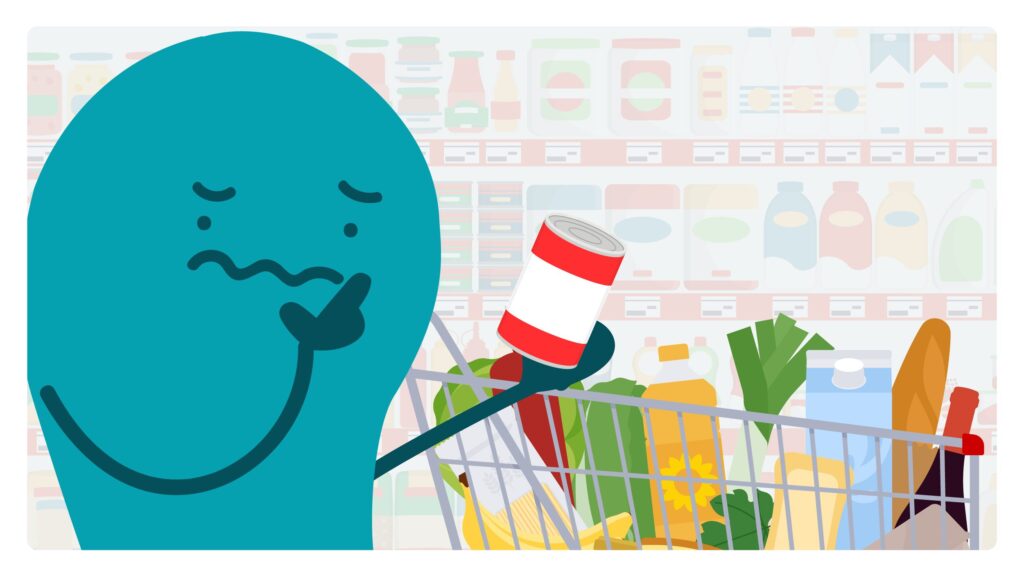
Lately, it feels like everyone’s talking about ultraprocessed foods — journalists, politicians, and your favorite podcast hosts. The term is a mouthful — literally and figuratively — and its definition isn’t always clear. For health communicators, that confusion is where our work begins.
So what does ultraprocessed really mean? And how can we talk about it clearly and compassionately? Let’s peel back the label!
The term ultraprocessed comes from the Nova food classification system, developed by researchers at the University of São Paulo in Brazil. Nova groups foods into 4 categories based on how much industrial processing they’ve undergone:
- Unprocessed or minimally processed foods — things like fruits, vegetables, eggs, or meat
- Processed culinary ingredients — like oil, butter, sugar, or salt
- Processed foods — like canned beans, cheese, or freshly baked bread
- Ultraprocessed foods — made mostly or entirely from ingredients not commonly used in home cooking, such as packaged snacks, soft drinks, instant noodles, frozen entrées, flavored cereals, and processed meats like hot dogs or chicken nuggets
In plain language: ultraprocessed foods are made mostly in factories, not kitchens — designed to be tasty, convenient, and shelf-stable.
Why this topic is tricky — and political
It’s no coincidence that ultraprocessed foods are making headlines. Recent studies have linked high intake of ultraprocessed foods to health risks like obesity, heart disease, and depression — but those findings come with caveats. Nutrition science is complex, and food companies have a lot at stake in how these studies are framed.
Globally, some governments — including Brazil and France — have used the Nova framework to shape dietary guidelines. In the United States, the Department of Health and Human Services is taking aim at ultraprocessed foods, but exactly how remains to be seen. Some industry groups argue that the term ultraprocessed is too broad, while public health advocates see it as a powerful tool for highlighting how food systems affect health. Add in the realities of food access, marketing, and health literacy, and it’s clear: talking about ultraprocessed foods means talking about systems, not just snacks.
What this means for health communicators
As the public conversation about ultraprocessed foods continues to gain momentum, people will look to communicators for clarity — and compassion. Here’s how to keep your messages grounded:
- Lead with empathy. Everyone’s food choices are shaped by their circumstances. So when you write about ultraprocessed foods, focus on empowerment over judgment. Avoid labels like “junk food” or “clean eating,” and stay mindful that convenience, cost, and culture all influence what people eat.
- Define the term, not the person. Focus on what ultraprocessed foods are — not who eats them.
- Keep context front and center. For many people, ultraprocessed foods are the most affordable or accessible option. Acknowledge those structural realities.
- Be transparent about uncertainty. Explain both what we know and what we don’t know about ultraprocessed foods. Note that experts don’t always agree on how to classify foods — and that the research is still evolving.
After all, effective health communication means helping people make sense of the available information, so they can make the decisions that are right for them — not telling people what to eat (or not).
The bottom line: Ultraprocessed foods are everywhere — and so is confusion about what that term really means. By defining it clearly, acknowledging context and uncertainty, and approaching the topic with empathy, health communicators can help audiences make sense of a complex (and loaded) conversation.
Copy/paste to share on social (and tag us!): Ultraprocessed foods are in the news — but what they mean for our health isn’t always clear. 🥫 Health communicators can help by clearly explaining what ultraprocessed foods are, avoiding stigma, and staying focused on empathy. https://communicatehealth.com/wehearthealthliteracy/a-lot-to-digest-communicating-about-ultraprocessed-foods/ #HealthLiteracy #PlainLanguage
Browse recent posts